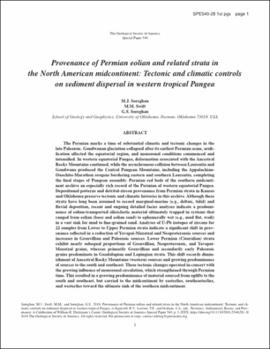| dc.contributor.author | Soreghan, M.J. | |
| dc.contributor.author | Swift, M.M. | |
| dc.contributor.author | Soreghan, G.S. | |
| dc.date.accessioned | 2020-06-02T15:53:58Z | |
| dc.date.available | 2020-06-02T15:53:58Z | |
| dc.date.issued | 2018-02-01 | |
| dc.identifier.citation | M.J. Soreghan, M.M. Swift, G.S. Soreghan, 2018. "Provenance of Permian eolian and related strata in the North American midcontinent: Tectonic and climatic controls on sediment dispersal in western tropical Pangea", Tectonics, Sedimentary Basins, and Provenance: A Celebration of the Career of William R. Dickinson, Raymond V. Ingersoll, Timothy F. Lawton, Stephan A. Graham | en_US |
| dc.identifier.uri | https://hdl.handle.net/11244/324805 | |
| dc.description.abstract | The Permian marks a time of substantial climatic and tectonic changes in the late Paleozoic. Gondwanan glaciation collapsed after its earliest Permian acme, aridification affected the equatorial region, and monsoonal conditions commenced and intensified. In western equatorial Pangea, deformation associated with the Ancestral Rocky Mountains continued, while the asynchronous collision between Laurentia and Gondwana produced the Central Pangean Mountains, including the Appalachian-Ouachita-Marathon orogens bordering eastern and southern Laurentia, completing the final stages of Pangean assembly. Permian red beds of the southern midcontinent archive an especially rich record of the Permian of western equatorial Pangea. Depositional patterns and detrital-zircon provenance from Permian strata in Kansas and Oklahoma preserve tectonic and climatic histories in this archive. Although these strata have long been assumed to record marginal-marine (e.g., deltaic, tidal) and fluvial deposition, recent and ongoing detailed facies analyses indicate a predominance of eolian-transported siliciclastic material ultimately trapped in systems that ranged from eolian (loess and eolian sand) to ephemerally wet (e.g., mud flat, wadi) in a vast sink for mud to fine-grained sand. Analyses of U-Pb isotopes of zircons for 22 samples from Lower to Upper Permian strata indicate a significant shift in provenance reflected in a reduction of Yavapai-Mazatzal and Neoproterozoic sources and increases in Grenvillian and Paleozoic sources. Lower Permian (Cisuralian) strata exhibit nearly subequal proportions of Grenvillian, Neoproterozoic, and Yavapai-Mazatzal grains, whereas primarily Grenvillian and secondarily early Paleozoic grains predominate in Guadalupian and Lopingian strata. This shift records diminishment of Ancestral Rocky Mountains (western) sources and growing predominance of sources to the south and southeast. These tectonic changes operated in concert with the growing influence of monsoonal circulation, which strengthened through Permian time. This resulted in a growing predominance of material sourced from uplifts to the south and southeast, but carried to the midcontinent by easterlies, southeasterlies, and westerlies toward the ultimate sink of the southern midcontinent.
This is a preprint of the item published on December 28, 2018 at https://doi.org/10.1130/2018.2540(28) | en_US |
| dc.description.abstract | This is a preprint of the item published on December 28, 2018 at https://doi.org/10.1130/2018.2540(28) | |
| dc.description.sponsorship | This 10 yr research project on midcontinent Permian red beds was supported primarily by funding from the National Science Foundation (EAR-0746042, EAR-1053018, and EAR-1338331). Open Access fees paid for in whole or in part by the University of Oklahoma Libraries. | en_US |
| dc.language | en_US | en_US |
| dc.subject | detrital zircon | en_US |
| dc.subject | paleoclimate | en_US |
| dc.subject | Permian | en_US |
| dc.subject | paleogeography | en_US |
| dc.title | Provenance of Permian eolian and related strata in the North American midcontinent: Tectonic and climatic controls on sediment dispersal in western tropical Pangea | en_US |
| dc.type | Book chapter | en_US |
| dc.description.peerreview | Yes | en_US |
| dc.identifier.doi | 10.1130/2018.2540(28) | en_US |
| ou.group | Mewbourne College of Earth and Energy::School of Geosciences | en_US |
